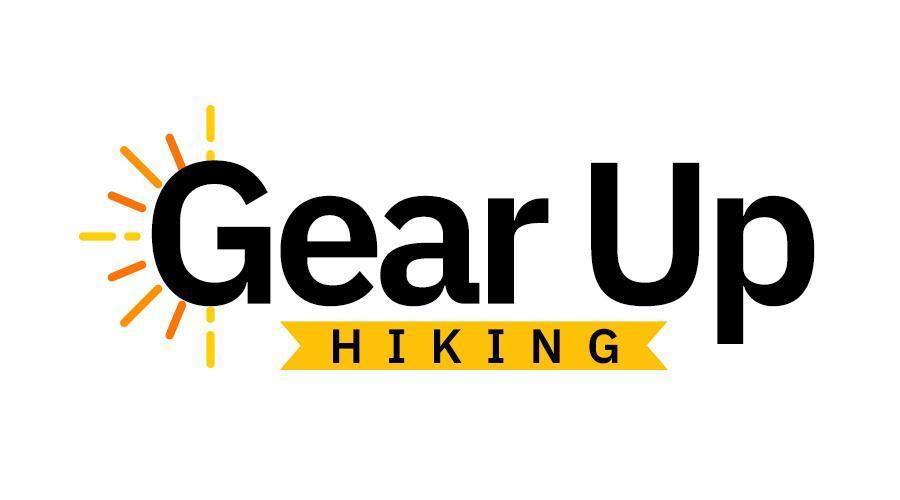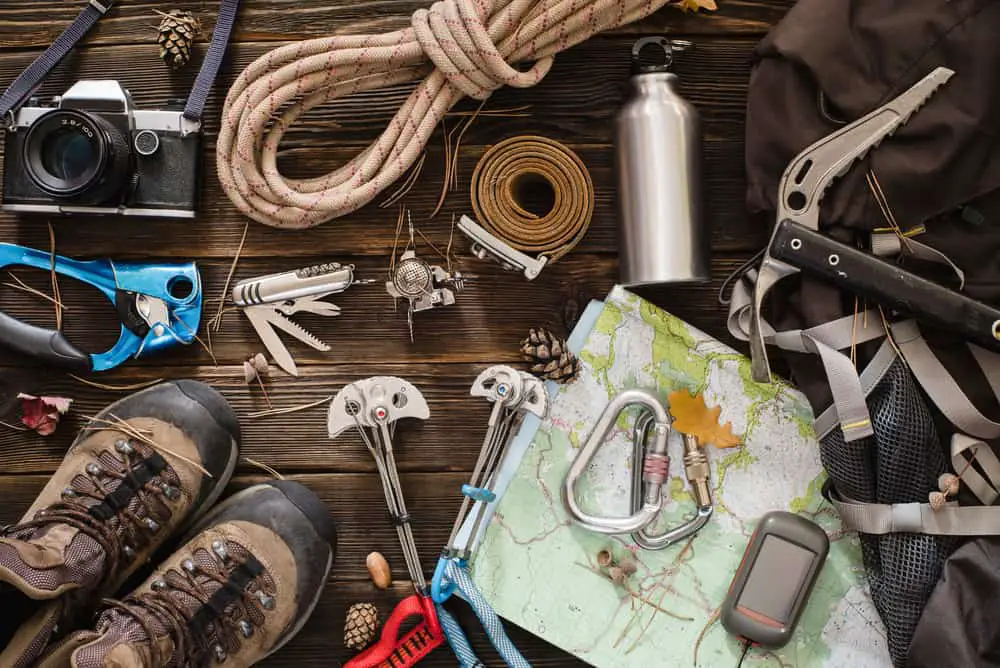The Very Best Lightweight Hiking Gear Of 2021 (MUST READ)
Are you planning a hiking trip anytime soon? If you are already an experienced hiker, you would probably be aware of the importance of carrying the best lightweight hiking gear on your adventure.
- Hiking Backpack: Gregory Optic 48
- Walking Poles: Rei Co-op Flash Carbon
- Hiking Boots: Merrell Moab Mid 2
- Headlamp: SureFire Maximus
- Water Filtration Bottles: LifeStraw Go
The right gear is essential, particularly considering the unpredictability and uncertainty of nature and what you may have to deal with. Thus, having the right equipment becomes more of a necessity.
Certain factors need to be considered before choosing the appropriate gear, especially when your primary factor is the weight.
However, you could still end up in a confusing state because of the diversity of selections that each of us faces when searching for lightweight equipment.
The critical problem with it is that everyone claims their product is the best, but that is not always the case.
That’s why we prepared a list of 10 essential hiking items that are not only lightweight but of highest quality and excellent customer feedback.
The products on the list have been selected after a detailed examination resulting in 20 hours of vigorous research and features comparison. Each selected product is rated as the best in its category. In each item description, we’ve also included our best choice for female-specific products, whenever that was applicable.
After the product list, we prepared a thorough buying guide that will help you develop a better understanding of what to look for in a product and its features. It would also assist you in better preparing for your hiking journey.
So let’s get you some quality ultralight backpacking gear.
Best Lightweight Hiking Gear: Quick Overview
| IMAGE | PRODUCT | DETAILS | |
|---|---|---|---|
Hiking Backpack 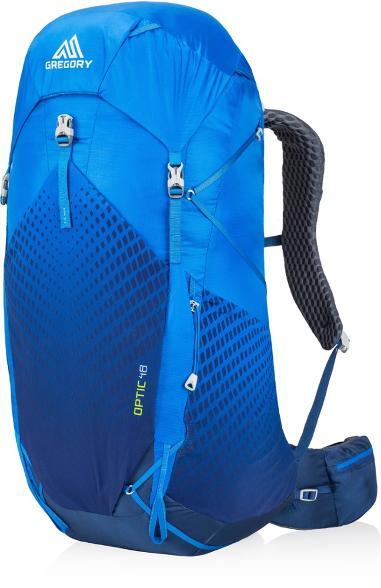 | Gregory Optic 48 |
| View Latest Price → |
Walking Poles 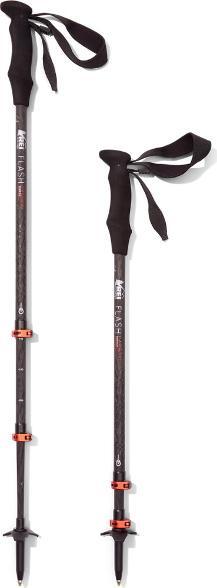 | Rei Co-op Flash Carbon |
| View Latest Price → |
Hiking Boots  | Merrell Moab Mid 2 |
| View On Amazon → |
Headlamp  | SureFire Maximus |
| View On Amazon → |
Water Filtration Bottles  | LifeStraw Go |
| View On Amazon → |
GPS Tracker  | Garmin Instinct Watch |
| View On Amazon → |
Survival Kit  | SurviveWare First Aid Kit |
| View On Amazon → |
Hiking Jacket 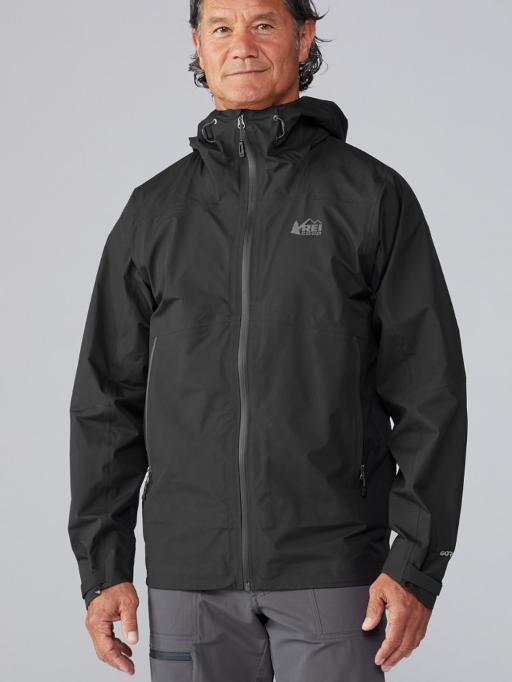 | Rei Co-op Drypoint GTX |
| View Latest Price → |
Hiking Pants  | Arc'teryx Lefroy |
| View On Amazon → |
Survival Shelter  | Go Time Gear Tube Tent |
| View On Amazon → |
#1 Backpack - Gregory Optic 48 L

Comfort and convenience are two things that are the most sought after in a hiking bag, and it is precisely what Gregory Optic provides. Especially if you truly care about your backpacking gear. Its ventilated AeroSpan suspension has a double-density focus form shoulder attachment that efficiently distributes the load, thus relieving the stress off of your back with directed comfort areas aid. This lightweight and well-organized pack will ensure all items you carry on your hiking trip are safe while you are comfortably moving across different terrains. Check it out.
The Gregory Optic pack comprises several key features that will ensure achieving maximum carrying comfort.
The premium Aero Span suspension, along with the EVAP humidity absorbing, narrow depth, aired back panel, ensures a breathable comfort level.
That helps your back remaining as sweat-free as possible on those long-distance hikes when that’s essential.
The bag comes in three sizes with different weights. The large one (51 L) weighs 2.6 lbs., the medium (48 L) weighs 2.5 lbs., and the small (45 L) weighs 2.4 lbs. only.
You should decide which one you would like to choose based on your preference in terms of volume.
The Optic has an ultra-light 7001 aluminum border frame which offers anti-barreling sustenance. That means the pack doesn’t shift and change its shape when you move, offering a comfy wear with even heavier loads.
The rain cover stores in the detachable upper pocket for fast access in unpredicted rainy conditions, which allows you to take instant action.
Thanks to the highly convenient QuickStow system, you can also store your sunglasses on the shoulder harness, and water bottles can be placed in the easily accessible, roomy side pockets.
The backpack has double zippered hip belt pockets that provide protected and easily accessible storage, so your stuff isn’t damaged along the way. A regular size smartphone easily fits in.
The twin stretchable mesh side pockets have a large capacity that you can use to store your water bottles or camp shoes.
They are easily accessible on the go which is pretty convenient so you won’t have to stop and then try to reach your flasks.
The Gregory Optic 48 has multiple gear loops including upper shock locks for securely attaching your trekking poles, as well as gear connection points on the main body and the top pocket of the bag. You can use those to attach your tent or sleeping bag, for instance.
So it provides efficient options to secure all your required items in a safe-friendly manner on the exterior of your pack. In case you like backpacking in the snow, you'll be able to store your snow shovel in this roomy pack. We have a list of the best ones here, if you're interested.
Ladies, the Gregory Octal 45 is a better choice for you because its construction and frame go better with the back of a female. Ultralight backpacking will never be the same with this awesome pack!
#2 Walking Poles - REI Co-Op Flash Carbon

Trekking poles are among the standard hiking equipment that helps maintain the rhythm and enhances stability, particularly on technical terrains. Those ultralight carbon trekking poles from REI are one of the best on the market right now because of their super light, yet robust construction, adjustability, and comfort. Don’t miss checking them out.
Perfectly suitable for ultralight backpacking, the walking poles have a superior grip that offers lightweight and airy EVA foam padding. It adapts to different hand sizes and positions, providing fantastic comfort on the trail.
The poles also have carbon fused design along with a triple-section form combined that minimizes weight without compromising durability.
The wrist strips are modifiable to provide better control over the poles. The power lock technology allows adjustments to be made conveniently while walking. The maximum length of the poles is 55” or 140 cm.
The sticks are well-fitted with trekking baskets and resilient tungsten tips made with carbide. On top of that, tip protectors are included for packing and carrying security.
The walking poles weigh only 14.8 ounces, which makes them super easy to carry and transport on every trip, particularly with bags that have separate compartments for them.
#3 Hiking Boots - Merrell Moab 2 Mid
You’ll agree that wearing the right shoes on a hike is essential not only for the sake of your comfort, but in some cases, it could be crucial for injury prevention. Coming from a reputable brand, these hiking boots are not only lightweight but also breathable, waterproof, and protect your feet in the most efficient manner possible.
One thing that we hikers hate is wearing heavy, uncomfortable boots on that long-awaited hike planned weeks and sometimes months in advance.
Probably you are aware that Merrell is the Cadillac of hiking boots. And the popular Moab 2 model will surprise you with comfort and durability. Moreover, it will make your ultralight backpacking trip easier.
The weight of the Merrell Moab 2 is only 1.2 lbs or 544 grams. And make no mistake, those boots are capable of serving you throughout your journey. Plus hundreds more, as stated by happy customers.
The shoes are made of suede leather and for further convenience have mesh uppers. The uppers have protective rubber toe covers with breathable mesh coating, allowing you to walk extensively without discomfort caused by blisters.
Another cool thing in these shoes is the bawled, foam closed-cell pads that prevent moisture and rubbish.
The Moab 2 model is waterproof, meaning that it can withstand moisture coming from rain, snow, and puddles. For maximum result, regularly spray them with impregnating spray.
The sole is Vibram TC5, designed to ensure perfect traction on various terrains. Additionally, the outsoles contain a 5mm depth of lug for better grip that will allow you to climb those rocky hills without slipping.
Merrell put an air cushion on the heels that provides anti-shock protection and increases stability when you walk on steep terrains.
A superb choice for women is the Salomon Outline Low GTX hiking shoes. They weigh only 1 lb. 5 oz, and feature Contagrip® outsoles, GORE-TEX® liners, and OrthoLite® footbeds that are completely removable.
And if you like to protect your feet, then check out some of the classiest protective boots by Merrell. They are heavier, though.
#4 Headlamp - SureFire HS3 Rechargeable
A reliable headlamp is something you can’t miss taking with you on your ultralight backpacking trip. Meet the highly rated Surefire rechargeable LED headlamp. Besides being ultralight, it offers some really handy features. It has a precision reflector that optimizes the light for your field of vision and you can adjust the level of light with one hand between 1 and 1000 lumens. On top of that, it’s very comfortable to wear thanks to the moisture-wicking and padded headband. Let’s see it.
A popular choice for many adventurers, the Surefire headlight weighs the impressive 5.1 oz. or 144 grams. That makes carrying it around virtually effortless. It'd be a weightless part of your backpacking gear.
What makes it quite comfortable to wear, however, is the advanced Breath-O-Prene forehead padding that dries fast and provides anti-chafing protection. That’s super important when you wear the headlamp for long in harsh conditions.
The light can deliver up to 1000 lumens of light, which would be enough to light up vast surroundings. In case you need a more concentrated level of light, you can easily decrease the lumens to up to 1. It is a nearly everlasting LED emitter structured to make the most of runtime and output.
For optimal performance, you can rotate the light assembly through 90 degrees, thus increasing your field of vision.
The tough lithium-ion battery is fully rechargeable and the shipping package includes chargers for regular outlets. As a bonus, the package also contains vehicle accessory chargers so you can charge the battery in your car.
#5 Water Bottles - LifeStraw Go Filtration
These award-winning bottles don't just store water. They purify water. And that’s something super convenient when being outdoors. Lifestraw’s innovative membrane filter provides two-stage filtration that kills waterborne bacteria, removes protozoa, and reduces chlorine and bad taste. Plus, they are reasonably priced and easy to carry. Check them out!
The bestselling LifeStraw Go water bottles are a true hit among the hiking community, and that’s for a reason. It will make an essential part of your backpacking gear.
They come in two sizes – 22 oz. and 1 L. The 22 oz. bottle weighs only 6 ounces or 170 grams. What makes them so special is the fact that they do a stellar work in filtrating water from pretty much any outdoor source – be it a river in the woods or a mountain lake.
That makes carrying water on your hike much easier because you can supply yourself with clean water on the go instead of carrying heavy gallons from home or waiting to get to a reliable source for a refill.
Each bottle contains a hollow filter membrane that not only kills all known harmful contaminants to keep you safe but it also eliminates unpleasant smell and chlorine levels. It filters 100 gallons (378 liters)
In addition, the activated carbon capsule reduces plastic chemicals and filters up to 26 gallons (100 liters) of water.
There’s nothing special in using the bottles. Sure enough, the filters are replaceable, and the material is durable and BPA-free.
They are so good that we’ve included them in our list of the best hiking gifts for outdoorsy fathers. They are just great for ultralight backpacking.
#6 GPS Tracker - Garmin Instinct Smartwatch
With over 50 days of battery life and featuring a bomb-proof and highly functional design that allows you to track and navigate through your itinerary, this Garmin GPS watch is the best in its class. In fact, it’s more than a GPS because it uses additional satellite systems for extra security and precision. Plus, it has the features of a smart fitness watch, offering you various data collection and smartphone integration. See it for yourself!
Mastering the science of navigating the outdoors without electronic devices is a necessary skill. Sometimes, though, it’s not enough.
With an excellent rating and thousands of positive user reviews, the GPS Garmin Instinct is ideal for any outdoor activity, including hiking, camping, and ultralight backpacking.
Its weight is the ridiculous 1.83 ounces or 51 grams. You practically don’t feel it on your wrist. Sure enough, the watch is as durable as an outdoor GPS gadget should be. It’s designed according to US military standards, meaning that it’s fully waterproof (up to 100 meters) and resists hot and cold extremities.
It has an integrated three-axis compass along with a barometric altimeter, in addition to various global navigation satellite systems (Galileo, Glonass and GPS).
Often, especially when you’re off the beaten path, relying on a single GPS is not enough so with this watch you have a solid backup.
What’s quite useful is the Trackback feature that allows you to set a starting position on the map and track your route back to it whenever needed. That really helps in not getting lost in the wilderness.
With the Garmin Instinct, you can also receive smart notifications on your smartphone as well as track and upload data related to your fitness and itinerary on the Garmin online community.
#7 Survival Kit - SurviveWare First Aid Kit
Compact, light, durable, and packed with every emergency item you might think of (100 to be precise), this SurviveWare first aid kit is a must for every ultralight hiker. The fabrics are waterproof not only from the outside but from the inside for full protection. But what’s even more useful is that each inner pouch is labeled based on its contents. Check it out!
They say safe is boring, be prepared.
With this compact and portable first aid kit, you’ll be prepared for any predicament that might happen when you’re outdoors. No matter if you’re hiking alone or in a group.
Weighing only 1 lbs., the kit gets you covered with more than 100 essentials including but not limited to:
…and many more. What’s cool is that the bag contains a CPR pouch and a detailed first aid guide. That’s super useful because often, when we found ourselves in an extreme situation, we tend to panic and don’t know how to react. Having a guide with clear instructions is quite handy.
The bag itself is made out of 600D polyester, making it as sturdy as a regular hiking backpack. It has D hooks and gear loops so you can easily attach it on the exterior of your pack if needed.
In fact, the bag has MOLLE system comprising several straps and gear loops so you can attach it practically anywhere.
What we like a lot about is that each inner compartment is labeled so you know exactly what’s inside. This could be extremely beneficial when you need to act fast and find that bandage without searching endlessly.
Furthermore, SurviveWare included additional empty space for your own items / medications. That’s very smart because often you need to bring a particular ointment or pills or whatever that applies to your own health or condition.
That makes the bag very suitable for old people or in general for folks who suffer from specific conditions such as bad knees or lower back pain and that require specific medications. The first aid kit is a must for senior hikers, too that are up to an ultralight backpacking trip.
#8 Hiking Jacket - REI Co-op Drypoint GTX
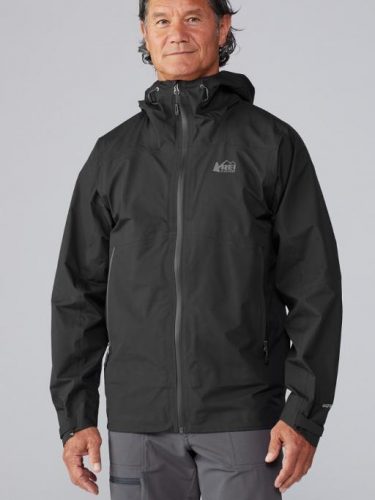
Favored by many outdoor enthusiasts, this jacket weighs only 10.5 ounces. People love it not only because it’s windproof and waterproof but because the GORE-TEX® Active fabric is light and super breathable. The hood is adjustable and with built-in visor, designed to fully protect you from the elements while not obstructing your vision. Really, check this jacket out and turn your ultralight backpacking trip into a success!
We all know a sturdy jacket is a must-have on outdoor trips, especially when you hike in bad weather.
But what makes all the difference when it comes to comfort, especially on prolonged hikes, is the weight and the breathability of the materials.
The REI Co-Op Drypoint is made out of 20D GORE-TEX Active 3-layer fabric that’s ultralight and breathable so you won’t feel like sweating in a bulky plastic bag.
The minimalistic design includes a 3-point adjustable hood that ensures perfect vision while protecting you from the rain and the wind.
Conveniently, the hand pockets are located a bit high in order not to get covered by the hip belt of your backpack. The pockets are mesh-lined and coated for water resistance and acts as core vents to let the heat quickly evaporate.
A fantastic choice for the ladies is the Marmot Lightweight Precip Waterproof Rain Jacket. Check it out here.
#9 Hiking Pants - Arc'teryx Lefroy
Made out of lightweight, breathable, and stretchy Aequora AirPerm fabric, those pants showcase the impeccable quality that Arc’teryx are widely known for. Ideal for prolonged trekking, the pants are breathable and with anatomic design so you practically don’t feel the garment when you walk. Check them out.
Designed for hiking in warm weather, the pants weigh only 7.2 ounces or 204 grams. That makes them an ideal addition to your lightweight gear checklist.
People love the Lefroy model mainly because of the Aequora AirPerm™ fabric that provides a high degree of breathability and water resistance combined with durability. The material is also moisture wicking and stretchy, which is exactly what we all need on hot summer hikes.
Thanks to the gusseted crotch, your movements are not obstructed in any way, which makes walking easy and comfortable.
The pants have an adjustable webbing belt and 3 pockets – two mesh lined hand pockets and one zippered thigh pocket, suitable for your mobile phone.
Being one of Arc’teryx most popular models, the Lefroy pants offer everything you’d want from your hiking pants. And that includes a reasonable price.
For female hikers, a fantastic choice and loved by many is the Columbia Saturday Trail Stretch Pant. It’s water resistant and the fabrics contain UV protection. They are just excellent for ultralight backpacking adventures. You might also want to check out this list of the best winter hiking leggings or our list of the sturdiest hiking pants with reinforced knees.
#10 Survival Shelter - Go Time Gear Tube Tent
Engineered to keep you alive in the most extreme situations, the Go Time shelter is easy to set up and carry and weighs only 8.2 ounces. It’s a robust two-person tube tent that’s fully waterproof, snowproof, and windproof. Its special interior reflects your body heat so you stay warm and dry no matter the weather conditions. Last but not least, the price is ridiculously low.
Truth is, most people don’t realize the importance of an emergency shelter. Moreover, they don’t pack one because they think it’s either bulky or expensive.
Well, that’s simply not the case. At least not with the Go Time Gear Tube Tent. Weighing only 232 grams, it will probably be the lightest item in your backpack. Plus, it packs in a 5.25” x 3.25” waterproof stuff bag. And it costs two movie tickets.
That’s impressive for something that can save your life when you’re into the wilderness, no matter the type and duration of your ultralight backpacking outing. You better be safe than sorry, right?
When harsh weather conditions occur unexpectedly or you need to spend an unplanned night out, you’ll be able to quickly set up the tent. This is done by running the 20 feet rope through both ends of the tent and tie it between two trees.
Then all you have to do is use rocks or anything else appropriate to stabilize the tent’s corners. The nylon cord paracord rope is super strong. It can endure 550lbs. of weight. You can even use it for other purposes. For example – to tie down gear.
Reflecting up to 90 percent of your body warmth, the interior is large enough and designed to fully protect you from the elements.
As you might expect, the material used is a sturdy polyethylene that’s puncture and tear resistant. On the compact stuff sack, there’s a 120-decibel whistle that you can blow and rest assured that everyone in a 1-mile vicinity will hear you.
Buying Guide (Plus Useful Info And Tips)
Hiking is among the most popular outdoor activities, with people of all ages finding excitement in it not only for leisure but because of its numerous physical and emotional benefits.
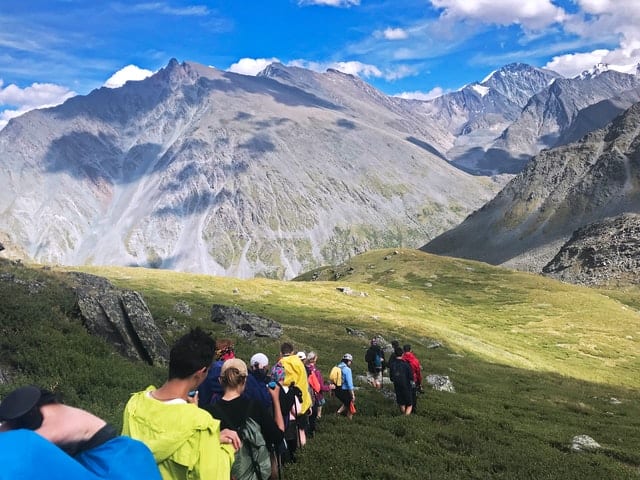
You’ll surely agree that it’s a splendid way of connecting with nature, but also with family and friends while maintaining your fitness level.
Whether you are on a ultralight backpacking trip for the first time or you are a professional with years of experience, taking the appropriate hiking gear is vital.
It’s something that just can’t be ignored because nature can be impulsive, and it’s better to be prepared for any situation that might arise. Not to mention that choosing the right items to take would greatly contribute to your comfort.
Selecting The Right Gear
As you probably know, there are some items that are indispensable for your hiking trip. Those are often referred to as the 10 essentials. Here’s the full list of important backpacking gear. And here are some solid tips on saving dollars on backpacking and camping gear.
Some of the stuff you can’t skip is a hiking pack, hiking boots, a headlamp (or a torch), water bottles, GPS tracker, first aid kit, and matches among others.
Since you’re reading this, you’ll agree that taking objects that are lightweight has plenty of benefits as compared to bringing your kitchen sink.
In fact, let’s quickly go through the main benefits of choosing hiking equipment that doesn’t weigh a ton.
5 Cool Benefits Of Selecting Lightweight Hiking Gear
The most critical benefits of choosing lightweight equipment are the following:
Lighter products are usually compact and easy to transport and carry.
Hiking involves climbing and walking through different terrains that are often technical. Carrying a heavy backpack would put your backbone, knees, and joints under a lot of stress. It could, therefore, lead to pain that could transform into a chronic condition. That’s why packing lightweight gear is an excellent way to decrease the likelihood of an injury.
Carrying heavy gear can drain your stamina a lot quicker. So, instead, if you replace it with a lightweight setup, you are likely to go far without getting tired as fast as you would normally do. It is a major benefit because often hiking is all about distance and endurance.
That’s pretty obvious – you just feel lighter and freer when your weight is as safely stripped off as possible. Climbing mountains and moving through steep paths can get hectic, and with all the extra weight on your back, it would get even more robust. So, you won’t be groaning with every climb. Ultralight backpacking gear is the answer, my friend!
Calm down. That doesn’t mean you can take unnecessary stuff that would take up more space in your pack. It rather means that you could take items that are important for you, but you normally wouldn’t take because of lack of space or fear of overstuffing your bag.
One important thing to note here is that in your effort to pack light you should make sure not to end up being unprepared. Ultralight backpacking doesn't mean unsafe backpacking.
Yes, it’s preferable to pack light, but it’s crucial to pack conveniently before anything else. Don’t make any sacrifices just for the sake of taking a light bag, because, in the end, it’s about carrying all the stuff you can’t go without in order to make your trip safe and comfortable.
Now let’s take a look at the different weight categories when it comes to hiking and backpacking and ultralight backpacking gear.
Weight Categories: The Basics
There are three general categories:- Base Backpack Weight - it includes the entirety of your pack apart from consumables (water, food, stove fuel, etc.).
- Worn Weight - things that are not present in your backpack, but you still carry them around on the trip (e.g., trekking poles, umbrella, and worn clothes
- Skin-out Weight - that’s the combined weight of everything apart from your body weight. The base weight is quite essential because it affects your experience on the trail to the highest degree.
On one hand, a base weight that’s too high could negatively impact your hike because you would be uncomfortably heavy. You don't want that when on an ultralight backpacking journey. On the other hand, a base weight that’s too low could make your hike dangerous and unpleasant because of the lack of some important gear.
In general, it’s your skin-out weight that matters the most during a hike. It’s the most accurate estimate to know how heavy your load is. So you need to ensure that your skin-out weight is as low as possible, to have a lightweight hiking trip.
Which takes us to the next point.
How Much Is Lightweight Exactly - The Truth
The next question that might arise in your mind is, how much weight do we need to carry to fit in the lightweight category? How ultralight backpacking fanatics answer this question?
Although the answer to this question could vary and the criteria might be different for some people (the sex matters too), we can group them in some general classes. Check out the video below which emphasizes on the importance of base weight.



When it comes to heavy, lightweight, and ultralight load, there are generally a few categories to keep in mind. We can further split the lightweight class into two sub-categories.
Let’s explore them in a bit more detail.
- The heavy hiking gear would be anything that exceeds 13.5 kg. (30 lbs.) base weight
- The traditional category is ranked between under 13.5 kgs (30 lbs.) base weight
- The lightweight category could be anything under or equal to 20 lbs. or 9-10 kg. base weight
Some skilled ultralight hikers and backpackers usually aim to achieve a base weight below 15 lbs. (6.8 kg.). Lightweight hikers strive to keep their base weight below 33 lbs. (15 kg.).
Lightweight can be further divided into ultralightweight and super lightweight. If you decide to go there, your base weight should not exceed 17 lbs. or 8 kg.
Hopefully that would give you an idea of what lightweight hiking means, knowing that these numbers are just a reference.
Always plan carefully and test. See how you will feel with your pack on your back, thinking about everything important that you have to take to make your journey comfortable and safe.
Remember that lightweight hiking is a process and you will learn and become better during trial and error.Choosing The Best Products For Your Lightweight Gear List (Plus Bonus Recommendations)
We all know picking the best essentials for you ultralight backpacking list is often overwhelming. That’s because you might find yourself in a sea of different choices when it comes to that type of backpacking gear.
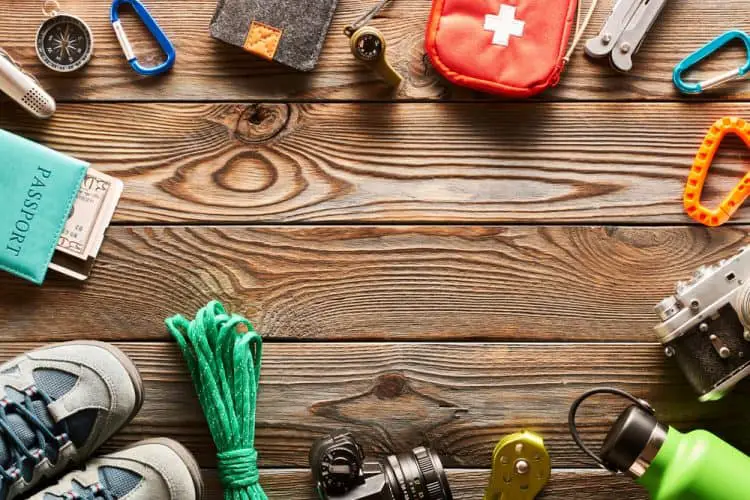
Don’t worry because we have you covered. Although certain factors relating to specific characteristics of products could vary, certain aspects apply to all of them.
Let’s see.
The Weight - What You Need To Know
Apparently, that’s the most important factor since we’re interested in lightweight hiking gear. All the products need to have the right weight, which in our case means as low as possible. After, all, we're talking about ultralight backpacking gear, right?
You can save weight by minimizing it on the bulkiest items on your backpacking gear list first. Those are usually your backpack, your sleeping bag, and your tent. Luckily, nowadays the manufacturing technologies and the materials are so advanced that you don’t have to sacrifice weight for durability or quality and vice versa. With the raising popularity of lightweight hiking, most of the reputable outdoor brands offer a good choice of lightweight equipment.
Note that a lightweight backpack shouldn’t exceed 2 lbs. 10 oz. or 1.1 kg. no matter the volume. Of course, that’s a rough estimate just to give you an idea.
Finding such packs is not so difficult. Based on our test and research, we included Gregory Optic 48 on our top gear list. Other popular brands that have light packs are Osprey, Deuter, and Hyperlite Mountain Gear.
You can examine some other great choices here at REI.
A lightweight sleeping bag shouldn’t exceed 1lbs. 15 oz. approximately, even it’s a winter one. REI have some good deals HERE. Hikers and backpackers particularly love the Rei Co-Op Magma Trail Quilt 30 since it’s well-insulated, comfy, and super light.
When it comes to lightweight hiking tents, the weight shouldn’t exceed 3.5 lbs or 1.60 kg. roughly. “Rei Co-Op” and “Big Agnes” are the leading brands that manufacture high-quality lightweight tents.
Check some selected choices HERE.
If you’re going on a shorter hike especially during the summer you can go even lighter by buying a shelter or a bivouac. They are also cheaper and less bulky.
Price - Surprise!
Let me tell you right away that the higher prices of lightweight products to include on your ultralight backpacking gear list shouldn’t surprise you. They are made of more sophisticated materials and require more complicated manufacturing technologies.
That’s why light products are pricier. Is it worth it? Absolutely.
Avoid alluringly cheaper products in that category because in most of the cases they don’t offer a sustainable weight to strength ratio. And that’s important for the overall quality of a lightweight product.
Still, you can find significant differences in prices depending on where you look. A diligent research is always required in order to find the best price. On our list, we considered the price factor offering you items with the best price possible.
Brand Reputation
Always go with reputable brands, known for the quality of their products. Avoid little-known shabby brands just because the price difference is massive. Remember that often the best quality comes at a bigger price and that’s the reality.
The last thing you’d want on your hiking trip is to end up with a torn-up backpack on the trail or realizing that your cheap shoes are not as waterproof as advertised. Usually cheap ultralight backpacking gear means lackluster gear.
Sure enough, there are occasions where less pricey products, coming from lesser-known brands rival and even beat the big shiny brands. We even compiled a list of the best cheap hiking backpacks that contains some awesome affordable packs from unknown brands.
However, based on our research and experience, it turns out this is not the case when it comes to lightweight hiking gear. For that, it’s highly recommended to go with well-known and established brands.
Conclusion
There you have it. That was a long article, but I hope you have a better understanding of the bestselling lightweight hiking equipment on the market right now. With it, you can make a pretty memorable ultralight backpacking trip. And as a tiny goodbye bonus we include this cool infographic that describes why the Appalachian Trail is so worth hiking. Check it out!
It’s important to note that we covered only some of the most essential items that you should bring with you. Before any trip, always prepare your own list and include or exclude any items that you find necessary.
That list will be constantly updated to reflect new products that will help you make your ultralight backpacking adventure cooler. With it and with the guide we provided (that I hope you find useful) you won’t end up spending your time and money on useless crap.
Do you have any personal feedback about some lightweight hiking gear that you’d like us to include on the list? Feel free to leave a comment below.
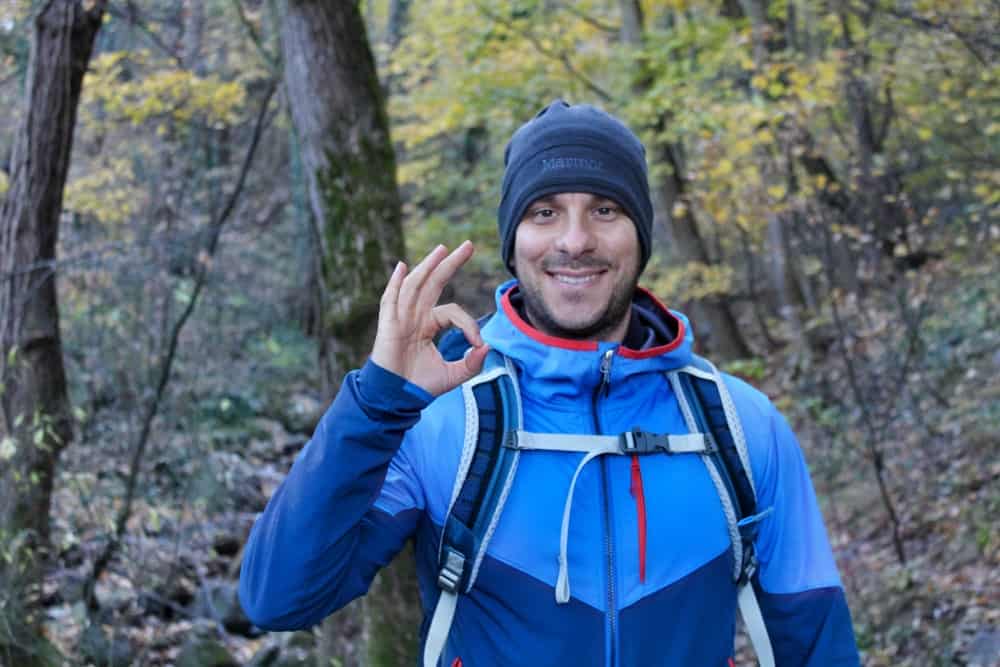
Asen Stoyanchev
Founder of this website, Asen is a passionate hiker and writer who is also a gear nerd. He’s been featured on many established hiking websites where he gives hiking advice & tips. When he is not trekking with his family or friends, he is writing articles and product reviews. Asen spends most of his time in Bulgaria but he constantly travels the world in seek of more unforgettable experiences. Read more about Asen here.
